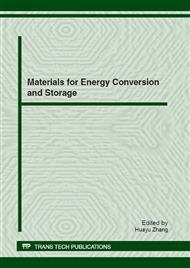p.41
p.45
p.49
p.53
p.57
p.61
p.65
p.70
p.74
The Parameter Estimate Method to Determine the Optimal Thickness for DSSC Electrode
Abstract:
For physical structure of TiO2 films is the core of photoelectric conversion on the photovoltaic performance of DSSC, the method by parameter estimate to determine the optimal thickness of DSSC working electrode is deduced, which is consistent with the analysis of real physical meaning about the TiO2 layer thickness and the photocurrent, while gives the specific optimal value as an addition. As a mathematical proof of the optimal conclusion extracting from the complex working mechanism of DSSCs and accidental factors, the equivalent circuit parameters of each curve are estimated corresponds to the equivalent circuit method first. According to the inflection point, which obtained through the synthesis of scattered experment points to the trend curve, the optimal thickness of DSSC working electrode are optimal identified.
Info:
Periodical:
Pages:
57-60
Citation:
Online since:
July 2012
Authors:
Price:
Сopyright:
© 2012 Trans Tech Publications Ltd. All Rights Reserved
Share:
Citation:


